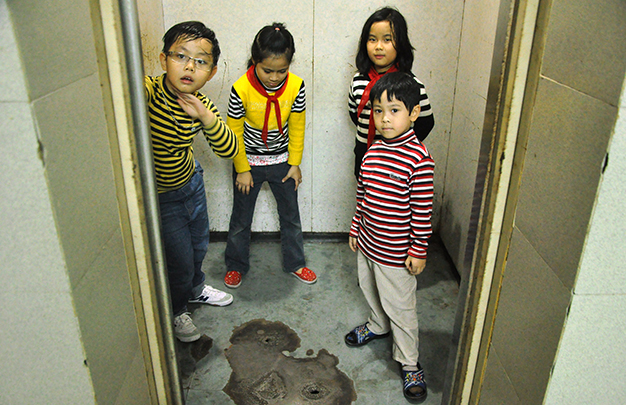Elevators can cause deaths in Vietnam thanks to technical problems, mostly in apartment buildings.
>> An audio version of the story is available here
They also create injuries, leave people stuck inside, and other inconveniences due to low quality or inadequate maintenance.
Residents say they have been living in anxiety but cannot help using the machines because of the height of their buildings.
Many have reported that they often get clamped by the doors of elevators and stuck inside the machines halfway up or down.
Some have even fallen to the ground since they enter elevators with open doors but without a floor inside.
On average, an elevator is supposed to work for 20 years, but the machines in apartments in Vietnam often function for just a few years.
“My apartment has two lifts but one was left unused long ago and the other has kept on ‘torturing’ residents thanks to its vibrations and cracking noise when in use,” said a female resident of the resettlement building G9 Xuan Dinh in Dong Tao Ward of Bac Tu Liem District in Hanoi.
“Mechanics said there are problems with the ball-bearings which create the sound.”
The Den Lu apartment buildings in Hoang Van Thu Ward of the capital’s Hoang Mai District has been open for ten years, but the lift of block G has been ‘dead’ for two years.
Other elevators at Den Lu have rusty floors and ceilings and the holes are getting wider.
Most of them have no battery in case the electricity goes out, so many have been locked inside with great worry for over an hour, said Dang Thuy Hang, 42, a resident of Den Lu.
Their emergency phones and alarms become useless during electricity blackouts.
“When it rains heavily, water leaks into the lifts. The water will overflow when it stops at a certain floor.
“We local residents dare not use it for fear of electric shock,” Hang added.
Le Thi Dan, head of the residential quarter, said that Den Lu has four lifts and they only worked well during the first two years.
“Recently, no mechanics have come to maintain the machines,” she said. “A person may be quickly clamped by the doors of a lift because it has a technical problem and runs too fast.”
Similar situations exist in other resettlement apartments.
Giang Van Phuc, 68, who lives in the N5C building of the Trung Hoa – Nhan Chinh resettlement apartment building in Thanh Xuan District, Hanoi said his ill wife has been ‘locked’ at home since the lift does not work and she cannot use the stairs.
The Hanoi Housing Management and Development Company, which is in charge of managing buildings for resettlement, said it manages 204 elevators in the capital city, 33 of which have been left unused.
Residents of building N5A at Trung Hoa – Nhan Chinh have ‘boycotted’ their lifts since last year after a guard was killed last June by a lift, said Le Hung, 62.
“We reported the problem to the Hanoi Housing Management and Development Company but they didn’t repair it and the fatal accident happened,” he said.
A lift must undergo technical maintenance at least every two months, said Nguyen Hong Thai, vice director of the lift-producing company ThyssenKrupp Vietnam.
Bui Quoc Dung, an official of the Hanoi Housing Management and Development Company, said the repair and maintenance of the lifts at the firm’s apartment buildings must be approved by the People’s Committee of Hanoi.
Then the committee will direct the finance department to provide money for the company to do the repair and maintenance work, so waiting is the only thing his firm can do now.
Like us on Facebook or follow us on Twitter to get the latest news about Vietnam!





















































